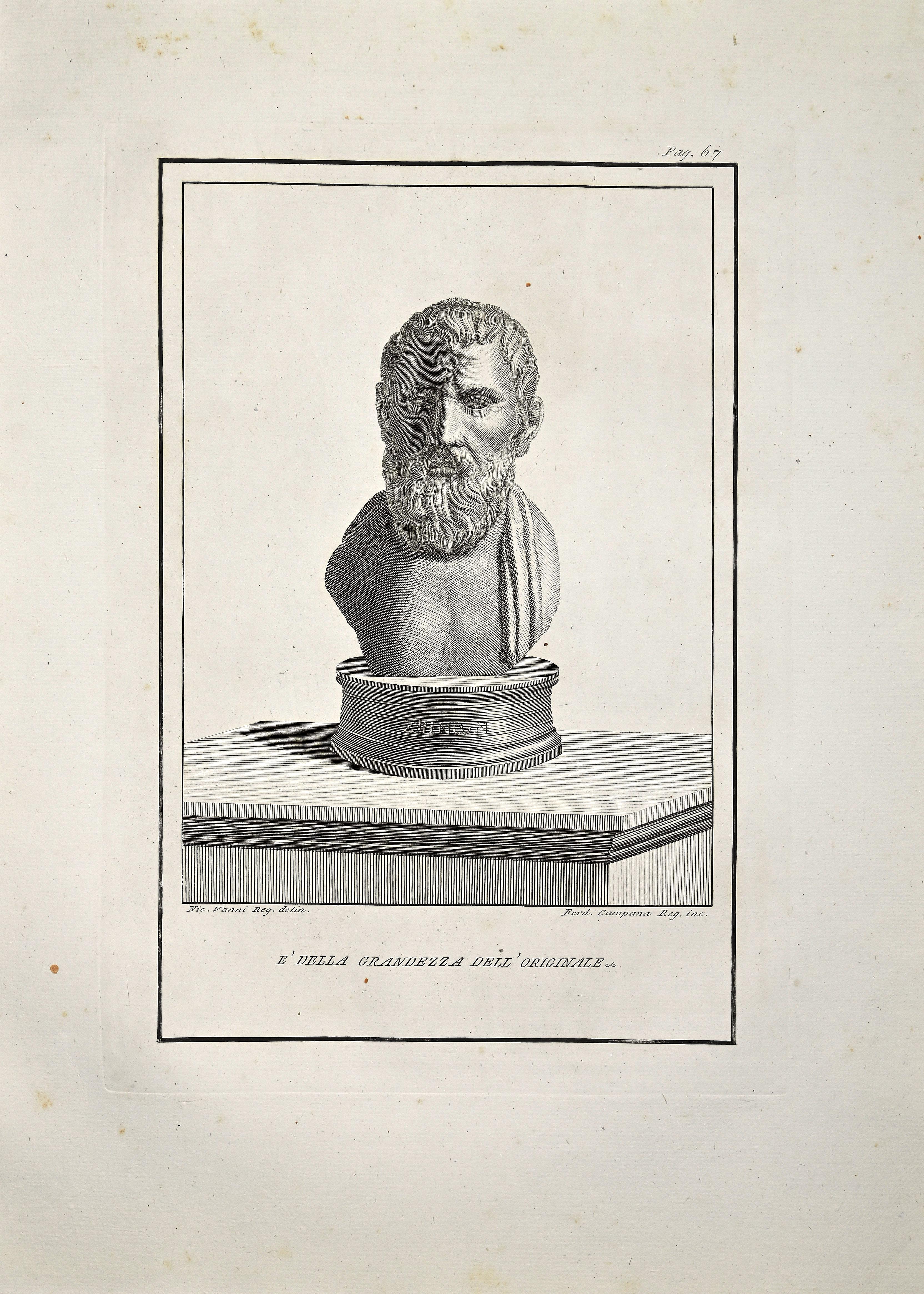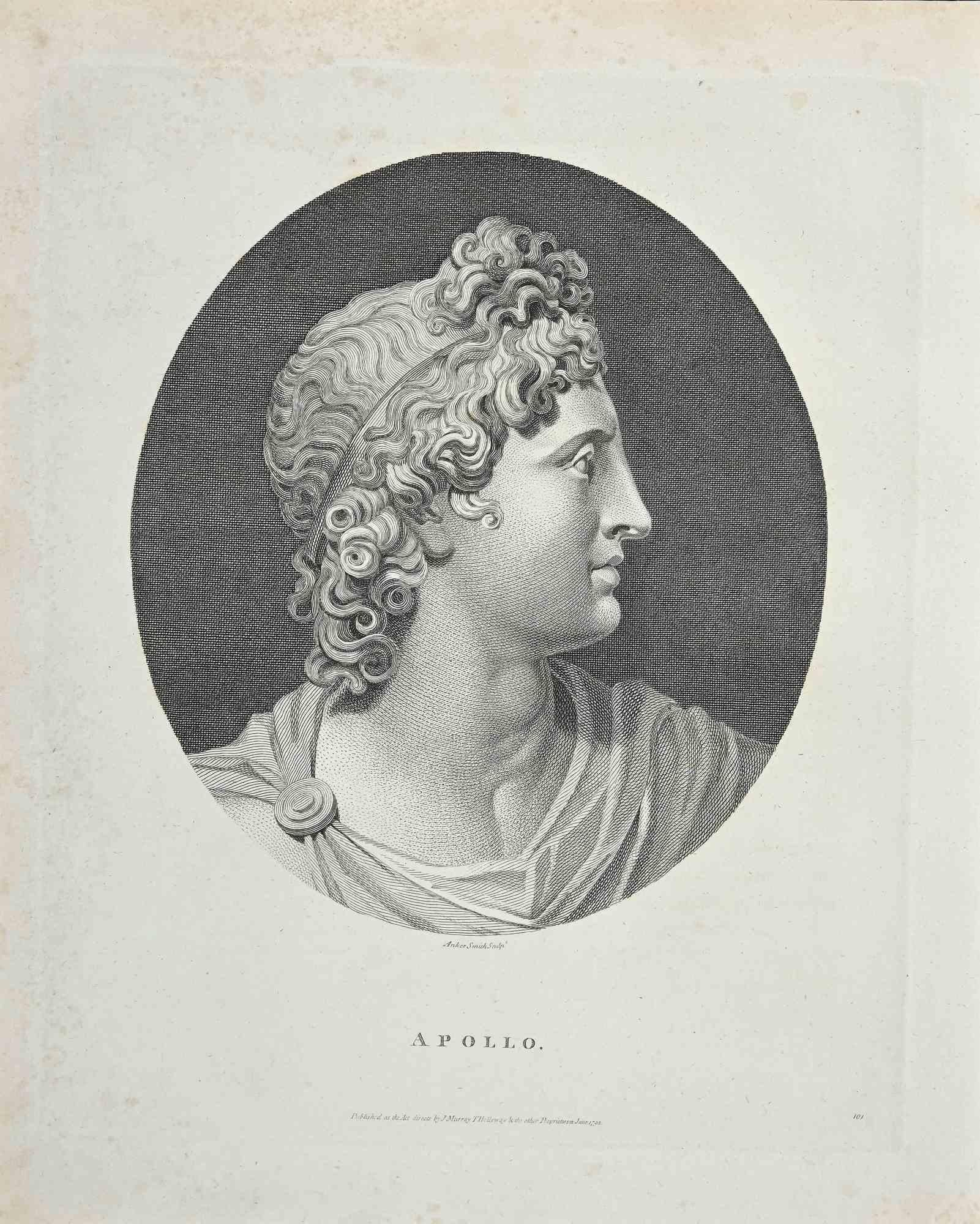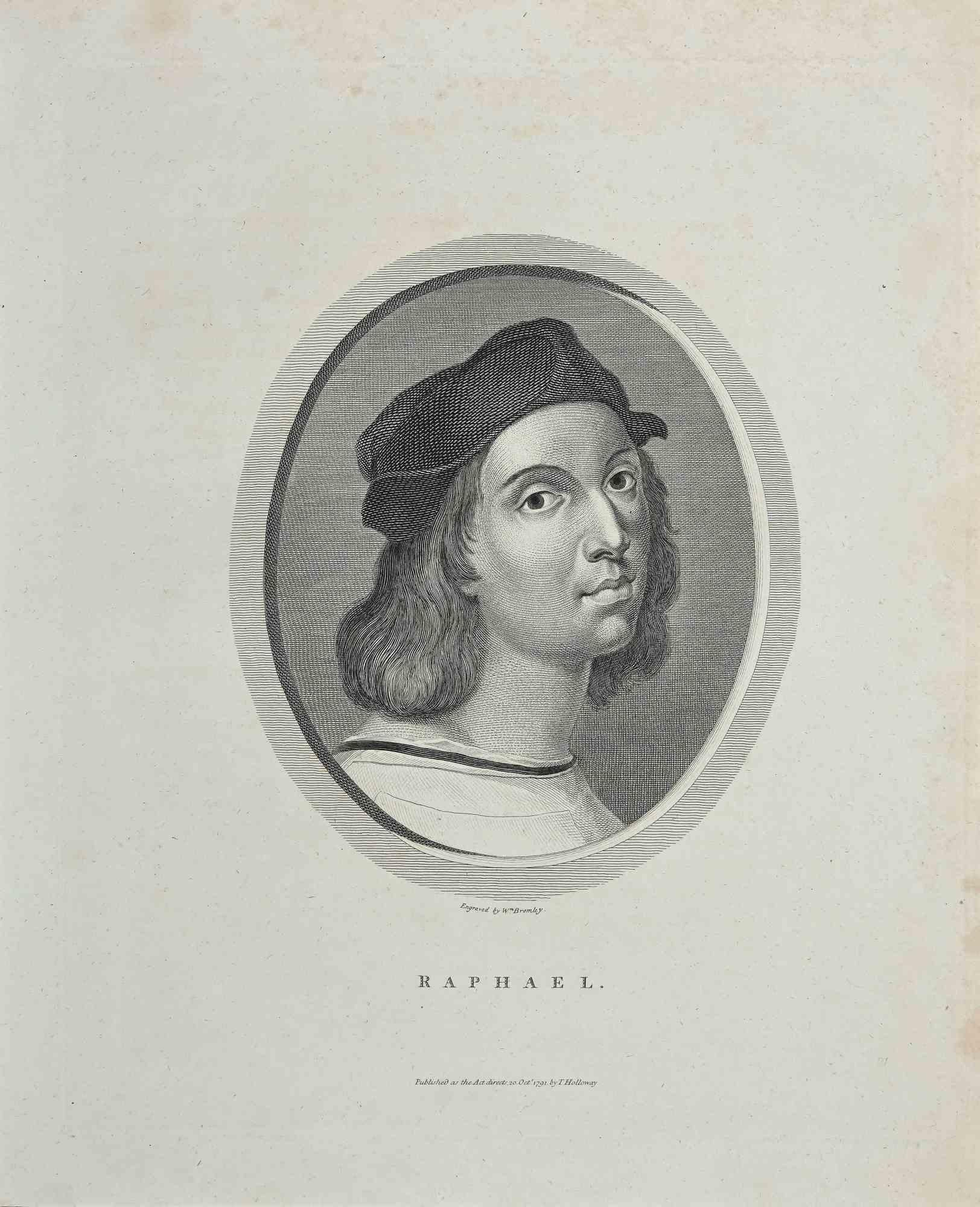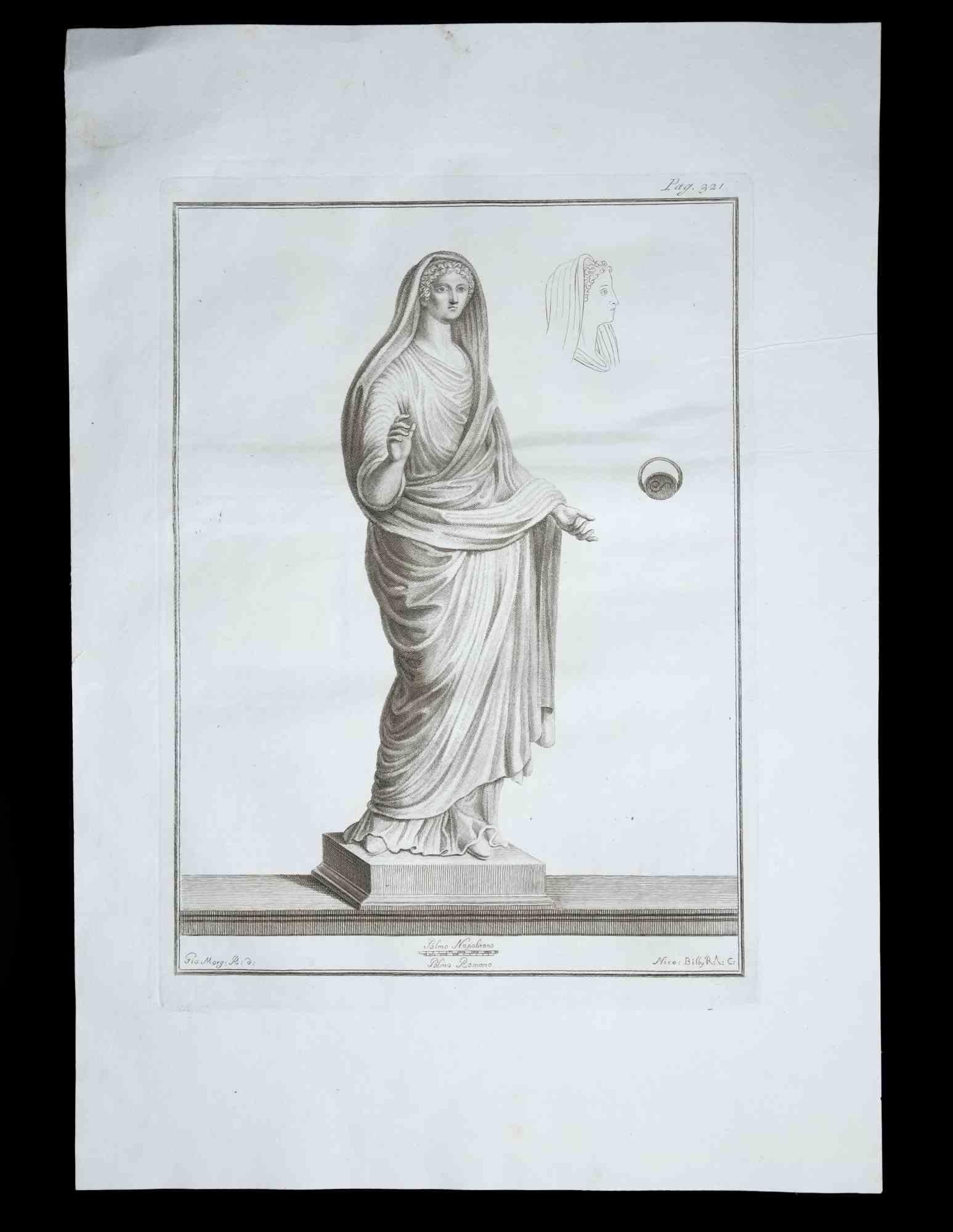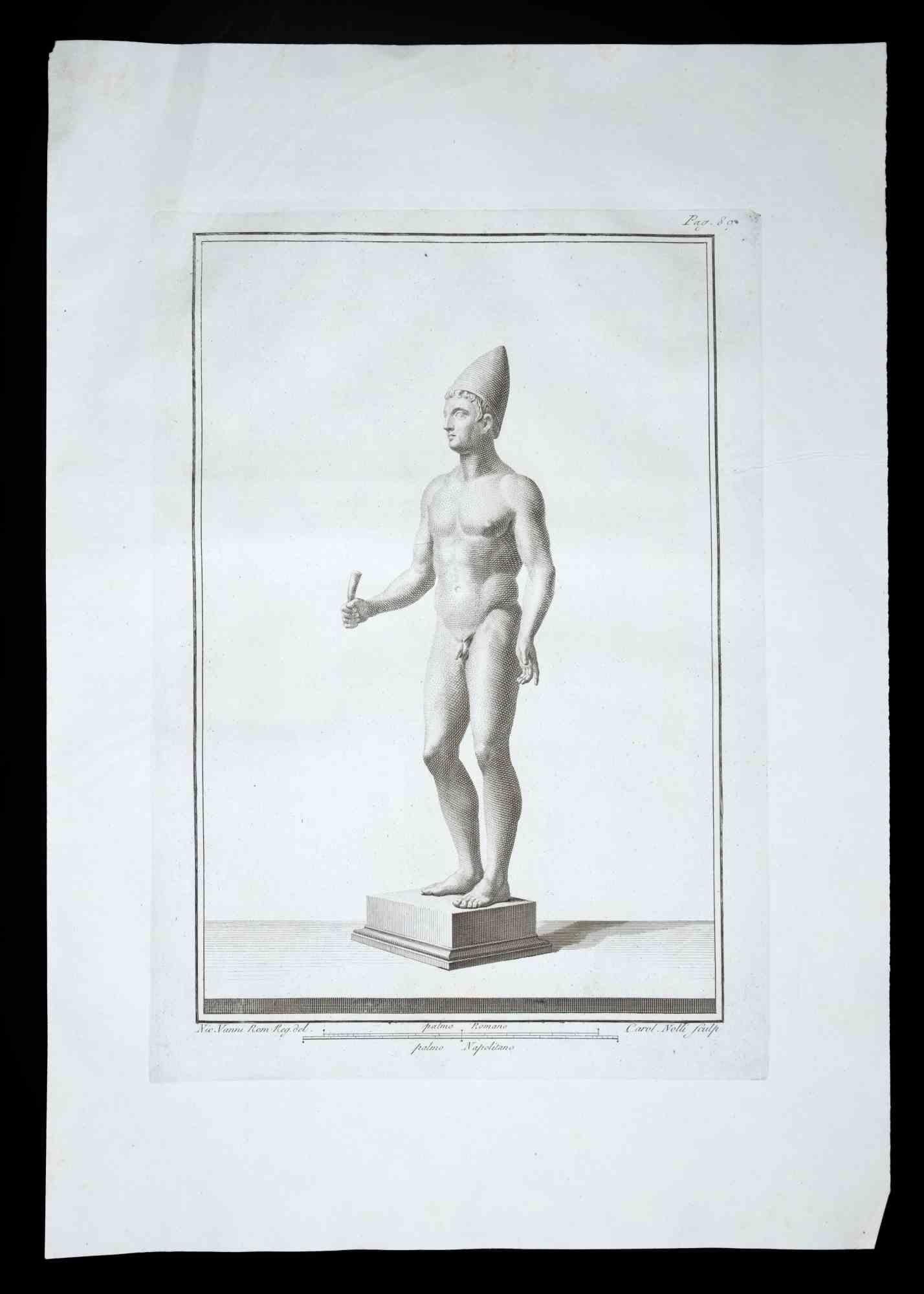Articles similaires à Buste romain ancien - gravure d'origine - 18ème siècle
Vous voulez plus d'images ou de vidéos ?
Demander au vendeur plus d'images ou de vidéos
1 sur 5
UnknownBuste romain ancien - gravure d'origine - 18ème siècleLate 18th Century
Late 18th Century
À propos de cet article
Ancient Roman Bust, original etching from the end of the 18th century, made by Various Old Masters.
Bon état.
Units of measurements typical of the period in the lower center of the margin: Palmo Romano - Palmo Napolitano. Bottom right and left the name of the artists: Joan.Casanova – Nolli.
The etching belongs to the print-series Antiquities of Herculaneum Exposed (original title: Le Antichità di Ercolano Esposte), eight volumes of engravings of the finds from the excavation of the ruins of Herculaneum in the Kingdom of Naples (today Campania, Italy).
It was published between 1757 and 1792 by the Regia Stamperia and later these copies were delivered to selected recipients throughout Europe.
Despite the title, the Antiquity of Herculaneum shows objects from all the excavations undertaken by the Bourbons in the Gulf of Naples. These include Pompeii, Stabia and two sites of Herculaneum: Resina and Portici.
The Bourbon king Charles commissioned fifteen scholars to create a new “Herculaneum Academy” to study the finds and publish the results of the archaeological excavations of the sites.
The engravings are of high quality and the accompanying text shows a large scholarship.
They were made by 25 leading artists involved by the King to prepare drawings and engravings on the finds, among which we find Giovanni Elia Morghen, Carlo Nolli, Luigi Vanvitelli and Giovanni Battista Casanova.
The "Antiquity" was designed more to amaze readers with the quality of the objects in the collection of the King of Naples than to be used in research, following and increasing the interest of eighteenth-century society for classical culture and art in particular.
Through the exaltation of the classical concept of proportion and harmony, the book inspired the neoclassical movement in Europe, giving artists and decorators access to a vast workshop of Hellenistic motifs.
Ref .:
National Gallery (Washington), Mark J. Millard Architectural, IV (2000), n. 1.
L. Garcia y Garcia, Nova bibliotheca Pompeiana (2 v., 1998).
Royal Institute of British Architects, British Architectural Library ... First Printed Books, 1 (1994), no. 112.
U. Pannuti, Engravers and designers of the Royal Printing House of Naples in the 18th century: the publication of the Antiquities of Herculaneum, in Xenia antiqua, 9 (2000), p. 151-178.
V. Trombetta, The edition of The Antiquities of Herculaneum exhibited in Rendiconti of the Academy of Archeology, Letters and Fine Arts of Naples, 59 (1984), p.151-172.
- Année de création:Late 18th Century
- Dimensions:Hauteur : 50 cm (19,69 po)Largeur : 38 cm (14,97 po)Profondeur : 1 mm (0,04 po)
- Support:
- Mouvement et style:
- Période:
- Encadrement:Options d'encadrement disponibles
- État:Insurance may be requested by customers as additional service, contact us for more information.
- Adresse de la galerie:Roma, IT
- Numéro de référence:
À propos du vendeur
4,9
Vendeur Platine
agréés par des experts, ces vendeurs sont les plus expérimentés sur 1stDibs et les mieux notés par nos clients.
Vendeur 1stDibs depuis 2017
6 794 ventes sur 1stDibs
Temps de réponse habituel : 3 heures
- ExpéditionRecherche du devis...Expédition à partir de : Grasse, France
- Politique des retoursCet article peut être retourné sous 14 jours à compter de la date de livraison.
Certaines parties de cette page ont été traduites automatiquement. 1stDibs ne garantit pas l'exactitude des traductions. L'anglais est la langue par défaut de ce site web.
Plus d'articles de ce vendeurTout afficher
- Buste romain ancien - gravure de Ferdinando Campana - fin du 18ème siècleBuste romain antique, de la série "Antiquités d'Herculanum", est une gravure originale sur papier réalisée par Ferdinando Campana. Signé sur la plaque, en bas à droite. Bonnes cond...Catégorie
Fin du XVIIIe siècle, Maîtres anciens, Estampes - Figuratif
MatériauxEau-forte
- Portrait du dieu Apollon - eau-forte originale d'Anker Smith - 1810Par Anker SmithPortrait d'Apollon est une œuvre d'art originale réalisée par Anker Smith (1759 - 1819). Gravure originale de J.C. Essais de Lavater sur la physiognomonie, destinés à promouvoir la ...Catégorie
années 1810, Maîtres anciens, Estampes - Portrait
MatériauxEau-forte
- Portrait de Raphaël - eau-forte originale de William Bromley - 1810Par William BromleyPortrait de Raphaël est une œuvre d'art originale réalisée par William Bromley (1769 - 1842). Gravure originale de J.C. Essais de Lavater sur la physiognomonie, destinés à promouvoi...Catégorie
années 1810, Maîtres anciens, Estampes - Portrait
MatériauxEau-forte
- Statue romaine ancienne - gravure de Giovanni Morghen - 18ème siècleStatue romaine antique, de la série "Antiquités d'Herculanum", est une gravure originale sur papier réalisée par Giovanni Morghen au XVIIIe siècle. Signé sur la plaque en bas à gauc...Catégorie
XVIIIe siècle, Maîtres anciens, Estampes - Figuratif
MatériauxEau-forte
- Statue romaine ancienne - gravure de Ferdinando Campana - 18ème siècleStatue romaine antique, de la série "Antiquités d'Herculanum", est une gravure originale sur papier réalisée par Ferdinando Campana au XVIIIe siècle. Signé sur la plaque, en bas à d...Catégorie
XVIIIe siècle, Maîtres anciens, Estampes - Figuratif
MatériauxEau-forte
- Statue romaine ancienne - gravure originale de Carlo Nolli - années 1700Par Carlo NolliStatue romaine antique, de la série "Antiquités d'Herculanum", est une gravure originale sur papier réalisée par Carol Nolli au XVIIIe siècle. Signé sur la plaque, en bas à droite. ...Catégorie
XVIIIe siècle, Maîtres anciens, Estampes - Figuratif
MatériauxEau-forte
Suggestions
- Funeral turc.Par Marius BauerUn enterrement turc. 1889. Aquarelle. Wisselingh 60. 3 3/4 x 5 1/2 (feuille 8 3/4 x 11 7/8). Edition 100, #9. Une impression richement encrée imprimée sur papier vergé crème de Str...Catégorie
Fin du XIXe siècle, Maîtres anciens, Estampes - Figuratif
MatériauxEau-forte
- Street à SmyrnaPar Marius BauerRue de Smyrne. 1889. Aquarelle. Wisselingh 34. 7 x 5 1/4 (feuille 12 7/8 x 8 7/8). 100 exemplaires, numéro 49. Une impression riche en tonalités, imprimée sur du papier vergé crème d...Catégorie
Fin du XIXe siècle, Maîtres anciens, Estampes - Figuratif
MatériauxPointe sèche, Eau-forte
- Cascade de cavalcade.Par Marius BauerUne cavalcade. 1888. Aquarelle. Wisselingh 107. 4 5/8 x 4 (feuille 11 5/8 x 8 3/4). Edition 100, n°46. Une impression richement encrée, imprimée sur papier vergé crème de Strasbour...Catégorie
Fin du XIXe siècle, Maîtres anciens, Estampes - Figuratif
MatériauxEau-forte
- Étude d'une têtePar Wenceslaus HollarPar Wenceslaus Hollar, d'après Jan Van Bylert (Biler) Gravure sur papier vergé crème, 3 7/16 x 2 3/4 pouces (87 x 70 mm), marges de fil. Il manque l'inscription dans la plaque ; "F...Catégorie
17ème siècle, Maîtres anciens, Estampes - Portrait
MatériauxEau-forte, Papier vergé
- Crucifixion : Gravure de Conrad Metz du 18ème siècle d'après Daniele da Volterra"Crucifixion" est une eau-forte et aquatinte, imprimée à l'encre brune par Conrad M&M. Metz d'après une peinture de Daniele da Volterra. Il a été publié à Londres en 1789 dans "Imita...Catégorie
Fin du XVIIIe siècle, Maîtres anciens, Estampes - Figuratif
MatériauxEau-forte, Aquatinte
- Le vendeur exceptionnelPar Adriaen Jansz van OstadeEau-forte et pointe sèche sur papier vergé crème, 4 x 3 3/8 pouces (102 x 86 mm), marges de 1/4 pouce. Signé dans la plaque, dans le coin inférieur gauche. Le 3ème état (sur 6), aprè...Catégorie
Milieu du XVIIe siècle, Maîtres anciens, Estampes - Figuratif
MatériauxPointe sèche, Papier vergé, Eau-forte
